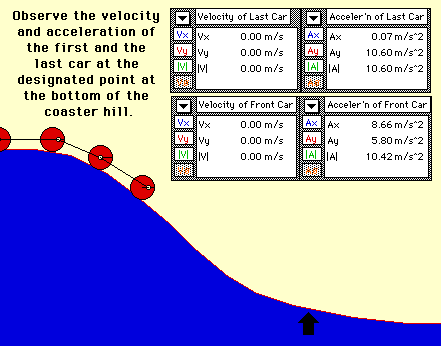

Roller Coaster Dynamics
How is a swimming start from a starting block like a roller-coaster ride?
How are the same forces used in different ways?
Like a roller coaster, the energy for a swim start comes from Gravitational Potential Energy by dropping from a height. Like Ski Jumping, the most important part of the jump occurs at takeoff. Within a tenth of a second, jumpers must combine two motions at once, leaping both up and forward at the same time. The timing of the take-off leap is what makes or breaks a jump.
Ski jumping converts gravitational potential energy to kinetic energy. (Kinetic Energy is energy of an object due to its motion). Roller coasters convert gravitational potential energy to kinetic energy. Swimmers starting from a starting block also convert gravitational potential energy to kinetic energy.

Similarly, increasing peak horizontal velocity will allow the swimmer to cover the start distance (the distance from the block to steady-state swim speed or to 15 meters (whichever comes first), in less time. See the following link for a slightly different demonstration, then click the BACK button on your browser to return here.
|
Another PowerStartsTM Secret |
In ski jumping and roller coasters, changing the launch angle will change the direction and duration of flight. Swimmers starting from a starting block also change the duration of flight by changing the launch angle.
Using the Force
Isaac Newton never had a chance to ride a roller coaster. The first one was built 75 years after his death. But the principles involved in roller coasters are right up Sir Isaac's alley. Newton's laws of motion describe how forces determine the motion of objects. Roller coaster designers rely on acceleration caused by those forces to make a roller coaster ride both thrilling and safe. The trick is knowing how to use the forces properly.
If the forces are too great in one direction, for instance, they'll throw the car off the track. If an upward force is too large (giving you a feeling of heaviness), your heart cannot pump enough blood to your head and you faint. On the other hand, the lack of supporting forces can create feelings of incredible lightness.
Force is a function of speed and change of direction. If the roller coaster car traveling fast down hill experiences a "sudden" change in direction, the car's acceleration changes. A bigger change in direction can make a bigger acceleration, such as a tight curve at the bottom of the coaster drop. The bigger the change in direction and the less time that change takes, the greater the acceleration.
This is exactly the same concept we have applied to the swim start and the force a swimmer creates when changing direction as he/she enters the water. (See Stage 7 of a Powerful Start).
The roller coaster designer must also keep those forces at safe levels. The designer has to stretch out the time and the distance it takes to navigate the curve at the bottom of the hill. This spreads the change out over time, decreasing the force over time.
A roller coaster track shaped into a curve takes up less space than one left in a straight line. Since land is expensive, the designers have to be creative about the use of space. However, the object of swimming is to get from one point to another point as efficiently as possible. We want to eat-up as much real estate as possible, as quickly as possible. The shortest route is a straight line. (We are talking about after we have achieved maximum velocity not before we jump).
Other Resources on this Subject
![]() Silverstein, H. (1996). Scream machines. Roller Coasters --Past,
present, and future. New York: Walker.
Silverstein, H. (1996). Scream machines. Roller Coasters --Past,
present, and future. New York: Walker.
![]() Timney, M.C. (1996, June) Ups and Downs of coaster physics.
Boy's Life, p.50
Timney, M.C. (1996, June) Ups and Downs of coaster physics.
Boy's Life, p.50
![]() www.rollercoaster.com
www.rollercoaster.com